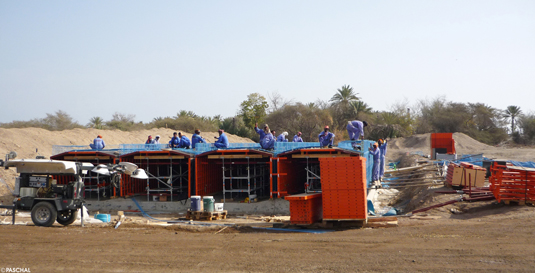Box culverts used as flood guards
Building express ways in the Sultanate of Oman
Modular/GE Universal formwork with moving unit deployed as bridge formworkIt is a frightening fact that most people who perish in the desert do not die of thirst but by drowning. While the scorching sun is shining from a cloudless sky it may be that far-away, and unnoticed a cloudburst happens in the mountains. Wadis are dry river beds with steep banks that may lie dry for years or even decades. They have always been used as a preferred traffic route to avoid the rough desert for the sake of convenience. When you are suddenly confronted with an onrushing wall of water, it may be too late already.
Şuḩār (Oman)
Economic development is only possible with a suitable infrastructure.
The capital of the Sultanate of Oman, Muscat, and Şuḩār, the country’s two biggest cities, are lying in the north-east of the country on the Gulf of Oman and are to be connected via a multi-lane express way. The distance between the two is approximately 300 km.
Construction begins at Şuḩār and runs to the south-east. There are many places where the future express way cuts across the alluvial deltas of wadis that run down from the mountain ranges; they are several kilometers across at their widest point. These pose a direct challenge to the construction companies. Soil conditions are irregular, future temporal and local variations of the rivers and their force are unknown and can only be determined statistically. A typical feature of these rivers is their varying bed load which includes all fractions ranging from giant boulders to fine sand plus any other objects that may be found in a wadi. This depends on the water’s energy: It is at a maximum close to the mountains and at a minimum in the alluvial deltas. In the deltas several, up to a dozen wadis may be found running side by side.
Organization
A typical construction site extends over 2-3 kilometers and employs up to 1400 workers which are housed in camps. There are two work shifts a day of 12 hours each, work is continuous round the clock. Due to high day-time temperatures concrete work is done mainly during night hours.
Concrete works
Flooded roads are dangerous. The entire carriage way will cross the wadis elevated by several meters. The sub-structure consists of parallel tubular culverts made of on-site concrete, allowing the passage of water anywhere.
 The basis of the structure consists of base plates each 36 meters long and made of on-site concrete. Countless numbers of these plates are lying side-by-side to form the foundation work. Along-side the wadi and at right angle to the direction of the traffic there are every 3 meters slightly elevated 20 centimeters wide wall foundations. Slight gradients lead up on either side of these foundations, thus forming shallow U-profiles. In this way the main flow is maintained in the profile’s center and unwanted lateral sedimentation by detritus is avoided.
The basis of the structure consists of base plates each 36 meters long and made of on-site concrete. Countless numbers of these plates are lying side-by-side to form the foundation work. Along-side the wadi and at right angle to the direction of the traffic there are every 3 meters slightly elevated 20 centimeters wide wall foundations. Slight gradients lead up on either side of these foundations, thus forming shallow U-profiles. In this way the main flow is maintained in the profile’s center and unwanted lateral sedimentation by detritus is avoided.
Work crews on several construction sites are working simultaneously now, erecting so called Box Culverts on the base plates. These are inconspicuous concrete boxes used for the construction of traffic routes world wide. If several of these boxes are lined up in series, they form a canal with a top-cover. If they are placed parallel and topped with a tarmac, they form a trafficable dam with tubes that are open-ended on either side.
These boxes can be manufactured on-site or they come as pre-fabricated module. NCC Limited of Hyderabad / India is the executing building company who decided to manufacture the modules from on-site concrete.

Four parallel running formwork carriages form the front of this big culvert. In the foreground a construction road runs from the left to the right. The future express way will run on top of the culverts also from the left to the right.
Formwork
With a limited quantity of formwork it is more effective to cast the boxes not in an in-line fashion but side-by-side: this way there are only two external walls but several internal walls.
Formwork drawings and procedures have been developed by PASCHAL-Werk G. Maier GmbH (Steinach / Germany).
PASCHAL Form Work (India) Pvt. Ltd. (Hyderabad / India) supplied a formwork carriage, which offers with a forming cycle of 12 meters (length) by 2 meters (height, minus gradients) and 3 meters (width), a form-work surface of 80 square metes with a length of 12.50 meters including excess length. Four of these carriages were placed side-by-side. The formwork system deployed for the walls and the slabs (both 20 centimeters thick) was the Modular/GE Universal formwork.
A typical feature of the Box-Culverts is the slanted slabs which mirror the bottom slants. The dismantling panels are integrated here and they are indispensable for formwork panels “cast-in-place” in confined building spaces, which otherwise can not be removed. The dismantling panels with well defined slanted slabs and bottoms are special components which were custom made by PASCHAL Concrete Forms Co. W.L.L. (Manama, Bahrain).
For each forming cycle the formwork panels were folded and all four carriages were simply shifted in the desired direction and aligned again in parallel fashion.
The three cycle sections, 36 meters in length, forming the sub-structure for the expressway were built in a superior manner, safely, conveniently and quickly.

Formwork carriage: Comprising a light movable scaffolding and orange-colored Modular formwork panels with a total length of 12.50 meters. On the slants the red dismantling panels can be seen.
Outlook
It will still take a number of years to complete the 300 kilometers of expressway and this will offer ample opportunities to deploy the carriage.
The co-operation of the individual PASCHAL locations has proven to be successful.
Modular/GE Universal formwork
Modular/GE Universal formwork is world-wide one of the most wide-spread and successful formwork system.
Due to an extensive range of panel heights and widths this range is the most versatile formwork system. For example for the panel height of 125 cm the following widths are available: 100, 75, 60, 50, 45, 43, 40, 37, 35, 33, 30, 25, 24, 20, 15, 12, 10 cm and the filler pieces are available as 6, 5, 4, 3, 2, 1 cm. Formwork may be fitted to the required architecture to within 1 cm. This obviates the need for complex final adjustments which cost time, money and labor. Panels are compatible with one another in horizontal and vertical position. An extensive range of accessories (corners / hinges etc.) supplements the portfolio.
The panels are capable of withstanding the pressure from fresh concrete (35 kN/m²) which is sufficient for most applications at medium rise structures. The GE large-size panels accept up to 60 kN/².
The relevant formwork software PASCHAL-PLAN light runs on any type of Personal Computer and is available in a number of languages: It is one of the most reliable software programs on the market. It is supplied by PLANITEC (Steinach / Germany).
In Central Europe “Modular” is mainly deployed for foundation work, crane-less sites, shafts, stair wells, polygonal components, columns, beams and pre-fabricated concrete parts. It is used everywhere, where standard formwork systems are too unwieldy, for example for finely stepped or angular building components, etc. In most other parts of the world it is being deployed as easy-to-use standard wall shuttering for plants, industrial structures and residential buildings, but even high-rise structures have been completed using Modular.
Modular has a 15 mm thick plywood which consists of 11-layers suitable for nailing from sustainable Finnish birch cultivations. The frame consists of a sturdy high-quality steel-grid, which is easy to clean and to repair.
It is by no means unusual that Modular is still in use after 25 years and thousands of field applications with only occasional repairs. Investment in a branded product has been worthwhile for these contractors.





